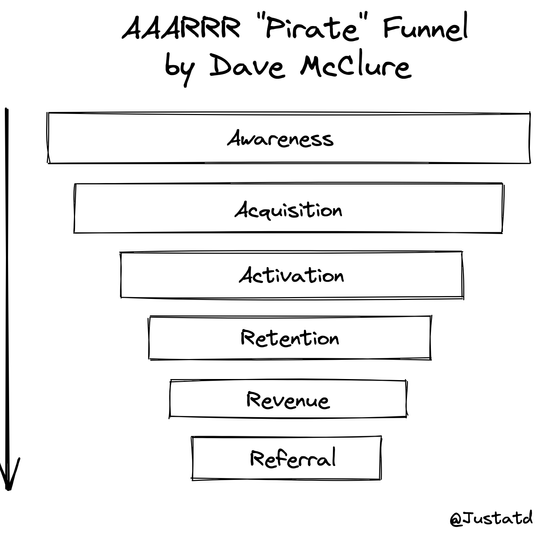
Today I will talk about the growth funnel framework “AAARRR,” which stands for Awareness, Acquisition, Activation, Revenue, Retention, and Referral.
The AAARRR framework (a.k.a. the Pirate Funnel) was developed by Dave McClure and is the most famous framework of “Growth Hacking.”
The top of the funnel is awareness, where you drive brand awareness of your product. Next is acquisition in which you convert new users into customers. Then activation, which provides a new user experience (NUX). Retention retains the customer in the funnel to unlock Revenue. Last is Referral, in which customers refer new customers.
A team that follows this framework will have dedicated members focus on each step of the funnel. For example, the PR and marketing team will work on driving awareness (blog, social, comms, and brand), while the acquisition team will work on acquiring users (performance marketing, in-product promotion, and website/mobile conversion optimization) and then hand over to the Activation/onboarding team (welcome new users) and so on. This structure helps different sub-teams deep-dive into their areas to work on their channels/functions, but may also create silos among teams as they may not share the same KPIs.
Now let’s talk about the concept of growth loops and why we should consider shifting from funnels to growth loops. Just one example is the “viral loop”: New users are acquired → users refer their friends → their friends accept the referral and become new users. Other examples are acquisition loops, retention loops, UGC (user generated content) loops, and experimentation loops.
An example of a growth loop for YouTube:
Creators upload videos on YouTube → Users watch videos → Advertisers run ads on videos to target users → Ads revenue allows YouTube to pay creators to create more videos.
Creating growth loops can generate more than one single impact. Brad Batesole from Madecraft succinctly said:
Growth loops provide a sustainable way to put some of that growth on autopilot. They’re useful for creating new users, bringing back old users, or even improving retention.
Companies must rethink how their internal teams (Product, Eng, UX, Marketing, and more) work together in order to create growth loops that work for their business models and customers. The growth loop will create a compounding effect on growth rather than just focusing on single steps such as in funnels.
Disclaimer: What I’m sharing here is my personal point of view and does not represent the views of my current and former employers.
This newsletter was previously sent on August 7, 2021


